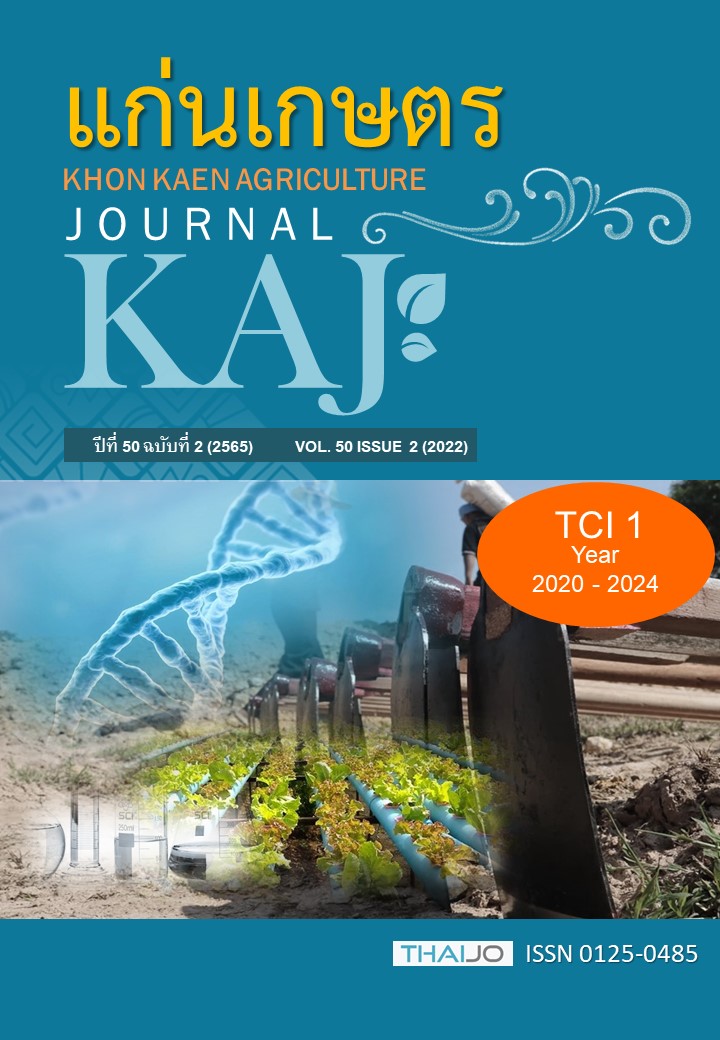เทคนิค rapid generation advance ในการศึกษาพันธุกรรมการถ่ายทอดลักษณะความไวต่อช่วงแสงในคู่ผสมระหว่างข้าวอายุสั้นพันธุ์ ULR368 และพันธุ์ กข6 ในการประเมินนอกฤดูปลูก
Main Article Content
บทคัดย่อ
การศึกษาพันธุกรรมการถ่ายทอดลักษณะความไวต่อช่วงแสงในข้าวได้มีการศึกษาในหลายงานทดลอง ซึ่งการศึกษาในข้าวที่ไวต่อช่วงแสงจำเป็นต้องมีการประเมินในฤดูกาลปลูก (นาปี) เนื่องจากการประเมินนอกฤดูอาจจะทำให้การศึกษาพันธุกรรมการถ่ายทอดมีความคลาดเคลื่อนเนื่องจากการออกดอกที่ไม่ปกติในกลุ่มพันธุ์ดังกล่าว ส่งผลให้การประเมินมีความล่าช้าเนื่องจากสามารถประเมินได้เพียงหนึ่งครั้งต่อปี ดังนั้นงานทดลองนี้จึงได้ศึกษาพันธุกรรมการถ่ายทอดลักษณะความไวต่อช่วงแสงในข้าวพื้นเมืองพันธุ์ ULR368 ที่ไม่ไวต่อช่วงแสงและอายุสั้น กับข้าวพันธุ์ กข6 ซึ่งเป็นพันธุ์ปรับปรุงที่ไวต่อช่วงแสงปานกลาง โดยใช้เทคนิค rapid generation advance (RGA) เป็นการควบคุมให้อยู่ในสภาพวันสั้น และเพื่อทดสอบความเป็นไปได้ในการนำเทคนิค RGA มาใช้ศึกษาพันธุกรรมการถ่ายทอดลักษณะความไวต่อช่วงแสง และใช้ในการคัดเลือกสายพันธุ์ในโปรแกรมการปรับปรุงพันธุ์พืช โดยทำการทดสอบความไวต่อช่วงแสงในลูกผสมชั่วที่ 1 และหาสัดส่วนของประชากรชั่วที่ 2 โดยใช้เทคนิค RGA ให้ข้าวได้รับแสงไม่เกิน 10 ชั่วโมงต่อวัน ผลการทดลองพบว่าเทคนิค RGA สามารถใช้ในการศึกษาพันธุกรรมการถ่ายทอดลักษณะความไวต่อช่วงแสงระหว่างคู่ผสมพันธุ์ ULR368 และพันธุ์ กข6 ได้ โดยผลการทดสอบสามารถจำแนกต้นที่ไวต่อช่วงแสงและไม่ไวต่อช่วงแสงได้อย่างชัดเจน และเมื่อทดสอบในประชากรชั่วที่ 2 ในระหว่างเดือน มกราคม ถึงเดือน เมษายน ซึ่งเป็นฤดูนาปรัง โดยใช้เทคนิค RGA พบว่า ประชากรชั่วที่ 2 จำนวน 191 ต้น ไวต่อช่วงแสง และ 177 ต้น ไม่ไวต่อช่วงแสง ซึ่งตรงกับสัดส่วน 9 : 7 (P<0.01) แสดงให้เห็นว่า ลักษณะไวแสงเป็นลักษณะเด่น ข่มไม่ไวแสง และมียีนควบคุม 2 ยีน ที่มีการทำงานร่วมกันแบบ complementary gene และยีนเด่น 2 ตำแหน่งนี้มีปฏิกิริยาแบบข่มข้ามคู่ (epistasis) นอกจากนี้ยังสามารถคัดเลือกประชากรต้นที่ไม่ไวต่อช่วงแสงและอายุเก็บเกี่ยวสั้นได้จำนวน 150 ต้น แสดงให้เห็นว่าการใช้เทคนิค RGA สามารถใช้ในการประเมินการแสดงออกของยีนในข้าวกลุ่มไวต่อช่วงแสงนอกฤดูการเพาะปลูกได้ และยังสามารถแยกกลุ่มสายพันธุ์ที่มีอายุสั้นและกลุ่มที่มีความไวแสงปานกลางออกจากกันได้ จึงเป็นเทคนิคที่สามารถใช้เป็นเครื่องมือ เพื่อย่นระยะเวลาในการประเมินลักษณะความไวต่อช่วงแสงในประชากรได้และสามารถนำมาใช้ในกระบวนการปรับปรุงพันธุ์ข้าวได้
Article Details

อนุญาตภายใต้เงื่อนไข Creative Commons Attribution-NonCommercial-NoDerivatives 4.0 International License.
เอกสารอ้างอิง
กรมการข้าว. 2560ก. ข้าวพันธุ์ กข6. แหล่งข้อมูล: http://www.ricethailand.go.th/Rkb/varieties/index.php-file=content.php&id=11.htm. ค้นเมื่อ 8 เมษายน 2564.
กรมการข้าว. 2560ข. ชนิดของพันธุ์ข้าว. แหล่งข้อมูล: http://www.ricethailand.go.th/Rkb/varieties/ index.php.htm ค้นเมื่อ 2 ตุลาคม 2564.
ธีรภัทร์ ธรรมไชยางกูร และ ธีรวัฒน์ ศรุตโยภาส. 2555. พันธุกรรมควบคุมลักษณะการตอบสนองต่อช่วงแสงในข้าวพันธุ์ดีเด่นบางพันธุ์ของประเทศไทย. วารสารเกษตรพระจอมเกล้า. 30: 13-22.
ประดิษฐ์ พงศ์ทองคำ. 2554. พันธุศาสตร์. สำนักพิมพ์มหาวิทยาลัยเกษตรศาสตร์. กรุงเทพฯ.
Arit, M.P. 1987. Genetics of basic vegetative phase, photoperiod sensitivity and critical daylength in rice. Ph.D. Thesis. University of the Philippines of Los Baños.
Collard, B.C.Y., J.C. Beredo, B. Lenaerts, R. Mendoza, R. Santelices, V. Lopena, H. Verdeprado, C. Raghavan, G.B. Gregorio, L. Vial, M. Demont, P.S. Biswas, K.M. Iftekharuddaula, M.A. Rahman, J.N. Cobb, and M.R. Islam. 2017.
Revisiting rice breeding methods – evaluating the use of rapid generation advance (RGA) for routine rice breeding. Plant Production Science. 20: 337-352.
Chandraratna, M.F. 1995. Genetics of photoperiod sensitivity in rice. Journal of Genetics. 53: 215-223.
Endo-Higashi, N., and T. Izawa. 2011. Flowering time genes Heading date 1 and Early heading date 1 together control panicle development in rice. Plant Cell Physiology. 52: 1083-1094.
Gomez, K.A., and A.A. Gomez. 1984. Statistical Procedures for Agricultural Research, 2nd edn. New York: John Wiley & Sons.
Hori, K., K Matsubara, and M. Yano. 2016. Genetic control of flowering time in rice: integration of Mendelian genetics and genomics. Theoretical and Applied Genetics. 129: 2241-2252.
Jiang, L., J. Xu, X. Wei, S. Wang, J. Tang, H. Zhai, and J. Wan. 2007. The inheritance of early heading in the rice variety USSR5. Journal of Genetics and Genomics. 34: 46-55.
Kojima, S., Y. Takahashi, Y. Kobayashi, L. Monna, T. Sasaki, T. Araki, and M. Yano. 2002. Hd3a, a rice ortholog of the Arabidopsis FT gene, promotes transition to flowering downstream of Hd1 under short-day conditions. Plant Cell Physiol. 43(10): 1096–1105.
Komiya, R., S. Yokoi, and K. Shimamoto. 2009. A gene network for long-day flowering activates RFT1 encoding a mobile flowering signal in rice. Development. 136: 3443-3450.
Poonyarit, M., D.J. Mackill, and B.S. Vergara. 1989. Genetics of photoperiod sensitivity and critical daylength in rice. Crop Science. 29: 647-652.
Sampath, S.ม and D.V. Seshu. 1961. Genetics of photoperiod response in rice. Indian Journal of Genetics Plant Breeding. 21: 38-42.
Shahidullah, S.M., M.M. Hanafi, M. Ashrafuzzaman, M.A. Salam, and A. Khair. 2009. Flowering response and crop duration of aromatic rices in diverse environments. Comptes Rendus Biologies. 332: 909-916.
Tsuji, H., K.Taoka, and K. Shimamoto. 2011. Regulation of flowering in rice: two florigen genes, a complex gene network, and natural variation. Current Opinion in Plant Biology. 14: 45–52.
Vergara, B. S., G. Patena, and F. S. S. Lopez. 1982. Rapid Generation of Rice at the International Rice Research Institute. IRRI Research Paper Series No. 84. Los Baños: International Rice Research Institute.
Yano, M., Y. Katayose, M. Ashikari, U. Yamanouchi, L. Monna, T. Fuse, T. Baba, K. Yamamoto, Y. Umehara, Y. Nagamura, and T. Sasaki. 2000. Hd1, a major photoperiod sensitivity quantitative trait locus in rice, is closely related to the Arabidopsis flowering time gene CONSTANS. The Plant Cell. 12: 2473–2483.
Yoshida, S. 1981. Fundamentals of Rice Crop Science. IRRI, Los Baños, Philippines, P.O. Box 933, Manila.
Zong, W., D. Ren, M. Huang, K. Sun, J. Feng, J. Zhao, D. Xiao, W. Xie, S. Liu, H. Zhang, R. Qiu, W. Tang, R. Yang, H. Chen, X. Xie, L. Chen, Y. Liu, and J. Guo. 2021. Strong photoperiod sensitivity is controlled by cooperation and competition among Hd1, Ghd7 and DTH8 in rice heading. New Phytologist. 229: 1635–1649.


